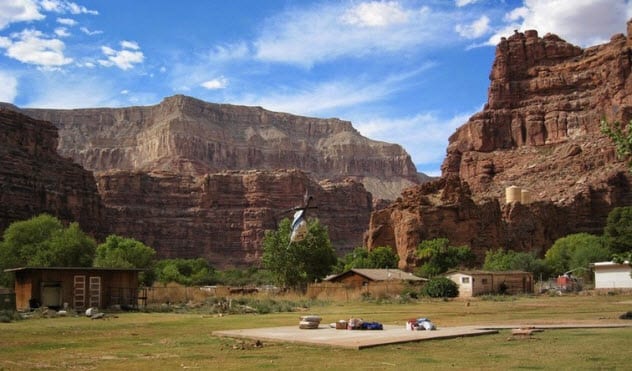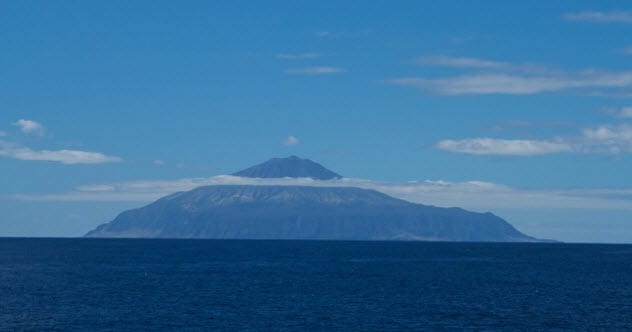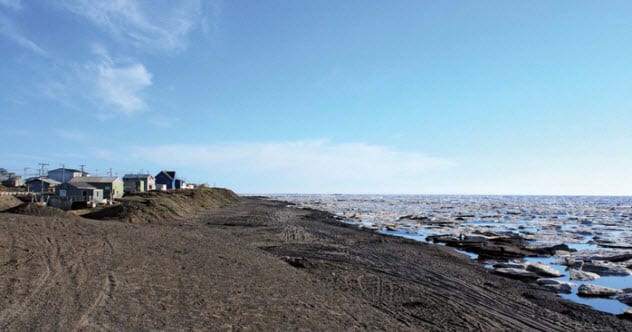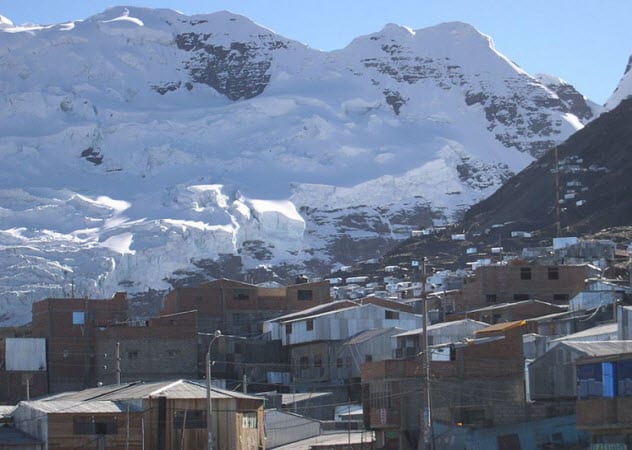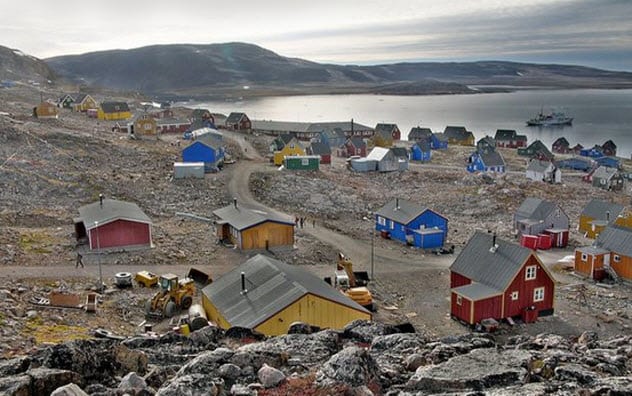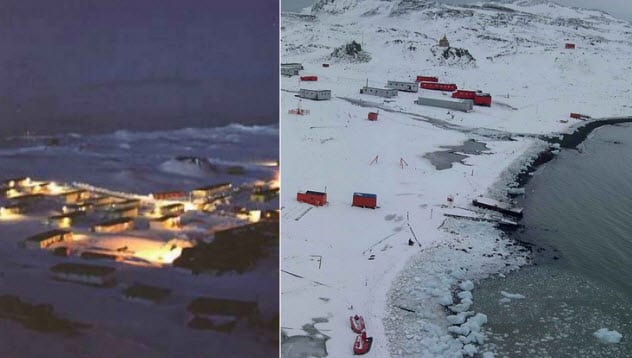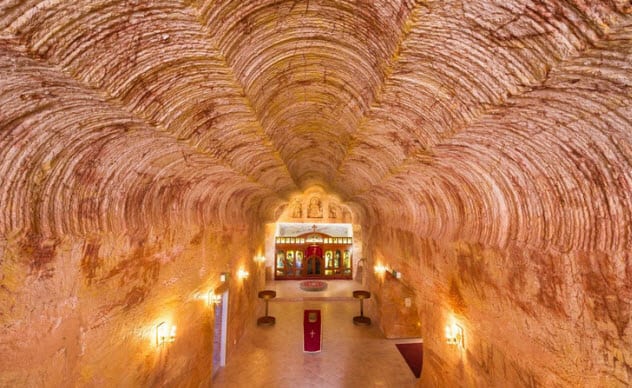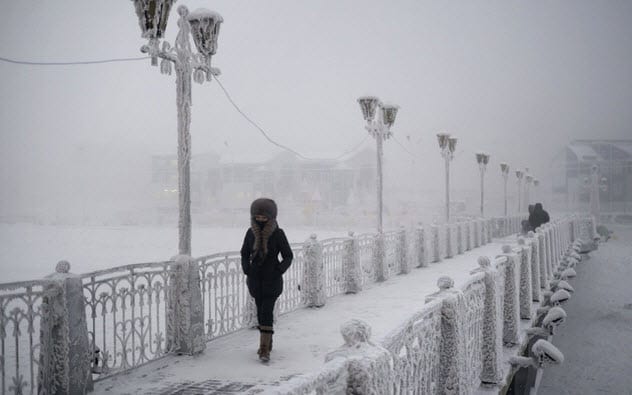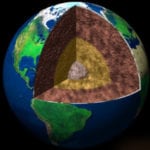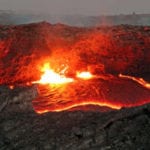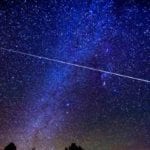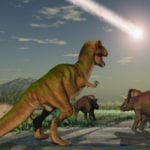However, some people have chosen to remain in smaller groups that are totally off the radar. These communities have withstood the test of time in near isolation. In fact, many residents have never left the small area of isolation they call home.
10 Palmerston Island
About 3,200 kilometers (2,000 mi) northeast of New Zealand sits the tiny island of Palmerston. Occupied by a mere 62 people who are all from the same bloodline, Palmerston is one of the most isolated communities on the planet. Discovery of Palmerston Island is credited to Captain James Cook in 1774. Upon his second voyage to the Pacific, he observed Palmerston. However, the captain would not set foot on the island itself until his third voyage in April 1777. At that time, Cook named the island Palmerston in dedication to Henry Temple, 2nd Viscount Palmerston, Lord of the Admiralty.[1] The 62 inhabitants of the island can be traced back to just one person, William Marsters. As the first permanent inhabitant of the island, he took up residency there in 1863 with his Polynesian wife and her two cousins. After being granted possession of the island by Queen Victoria, Marsters took his wife’s cousins as his second and third wives. He and his wives had 23 children in total. Before his death in 1899, Marsters separated the island into three parts and gave one part to each of his wives. Today, all but three of the people on the island are direct descendants of William Marsters. Life on the island is one of isolation and simplicity. There are no shops, banks, or markets. Money is only used when buying and selling off the island or when ships come with supplies from the outside world. Trade between islanders is the only way to get what you need. There is no true water system. Rainwater is collected for drinking, and there are two public toilets available on the main street. Electricity is only available for six hours each day. However, a new telephone station has been constructed to provide an easier connection to the outside world. The islanders rely mainly on fish and coconuts that can be found on the island. Ships come a few times a year to provide some supplies, but regular shipments are not available due to the isolated nature of the community. If someone wants to visit Palmerston as a guest, he will be welcomed with open arms. The islanders love visitors and “adopt” any travelers as their own. Guests stay in the islanders’ homes as there are no hotels. However, the journey will be grueling. Palmerston is about 500 kilometers (310 mi) from the capital island of Rarotonga. It is two days sailing on Pacific seas. Boats going to the island are few and far between. So if you are looking for the ultimate island getaway, Palmerston may be for you!
9 Supai Village, Arizona
The Grand Canyon is one of the most visited vacation spots in the United States. With its breathtaking views and desert-dwelling critters, the canyon provides tourists with an escape from reality. However, many do not know about the secluded village of Supai, which is located in a side branch of the Grand Canyon known as Havasu Canyon. The village consists of members of the Havasupai tribe. They have inhabited the area for the past 800 years.[2] The Havasupai people (aka “the people of the blue-green waters”) thrive in this arid, solitary landscape by practicing irrigation farming in the summer as well as hunting certain animals available during the seasons. The blue waterfalls and springs provide the Supai villagers with both their namesake and their water source for survival. The land in which the Havasupai live is a protected reservation. When the United States government began taking over the native lands in the 1800s, the Havasupai were unfortunately affected like so many other tribes. Their lands were bought up, and the tribe went from having over 1.6 million acres to only 518 acres. This confined them to the small, secluded patch of land they call home today. Just how secluded is Supai Village? The 208 residents are the only people in the United States who still receive their mail and parcels by mule. A series of linked mules carry packages and mail to the village regularly. Any mail leaving there also bears a postmark that is unique to Supai. Tourists are welcome to visit Supai and its natural beauty, but it will take some rugged skills and determination to get there. The village is located nearly 56 kilometers (35 mi) from the tourist hub of the Grand Canyon, and there are no paved roads to get there. The journey starts at the Hualapai Hilltop. From this point, Supai can only be reached by foot, mule, or helicopter. It is 13 kilometers (8 mi) one way to reach the bottom of the canyon where the village lies. Adventurers are advised to be fit, athletic, hydrated, and prepared for a difficult desert hike. Temperatures can reach as high as 46 degrees Celsius (115 °F). When they do, all hiking trails are closed within the area, so be prepared for a closure by the park service for your safety. Supai will remain a hidden gem in the American frontier.
8 Tristan Da Cunha
No restaurants. No hotels. No credit cards. No safe beaches. This is the life of those living on Tristan da Cunha, the world’s most remote populated island. (Both the archipelago and the main island in the group are named Tristan da Cunha.) These islands are in the middle of the Atlantic, i.e., the middle of nowhere. Tristan da Cunha lies 2,816 kilometers (1,750 mi) from South Africa and 3,360 kilometers (2,088 mi) from South America. The nearest landmass to Tristan is Saint Helena, which is a mere 2,430 kilometers (1,510 mi) from the island. Tristan was discovered by Tristao da Cunha in 1506. Unable to venture onto the island due to unsafe water, Tristao da Cunha named the main island (and the archipelago) after himself and took off. The first official mapping of the island was made by the French frigate L’Heure du Berger 261 years later. No attempt was made during the expedition to land on the island. The first true inhabitant of Tristan da Cunha arrived in 1810 when American explorer Jonathan Lambert landed on the island and proclaimed himself as its ruler. He even renamed the archipelago “The Islands of Refreshment.” His reign was short-lived, however, as Lambert was killed in a boating accident two years later. The islands were renamed Tristan da Cunha again.[3] Due to the strategic positioning of the islands, they were annexed by the United Kingdom in 1816. Today, Tristan da Cunha is thriving with a population of 267 people. These individuals have access to many major amenities, including a hospital with dental treatment and operating theater as well as a grocery store. However, orders must be made weeks or even months in advance for grocery items as everything must be shipped to the island from the nearest location. Though modernity has taken over, the remoteness of the island still causes many hardships. Traditional electricity is not available anywhere on the island. Instead, diesel generators are centrally located between cottages in the only town, Edinburgh of the Seven Seas. The 70 families that live in Edinburgh of the Seven Seas are farmers. Land is communal between families, and cows can be seen grazing peacefully along the single road on the island. Tristan da Cunha seems like an introvert’s paradise without any worries or anxieties. However, if this seems like a great place to settle down, be warned that the island is volcanic. Edinburgh of the Seven Seas sits at the base of a volcano that last erupted in the 1960s. So if you love remoteness, cows, and the threat of volcanoes, Tristan da Cunha may be the right home for you!
7 Utqiagvik, Alaska
Utqiagvik is the northernmost city in America and the ninth-most northern city in the world. Formerly known as Barrow in Alaska, this town lies well above the Arctic Circle and is a very remote and cold town. Although the weather is extreme, archeological evidence indicates that people have been thriving in the Utqiagvik region from as early as AD 500. The headland was explored in 1826 by Frederick Beechey and named for Sir John Barrow, the prominent British promoter of Arctic explorations. The native Inupiat tribe call the area Ukpeagvik (“Place Where Owls Are Hunted”). So, just how cold is Utqiagvik? The city is built upon a layer of permafrost that is up to 400 meters (1,300 ft) deep in places. The warm season in Utqiagvik lasts a mere 3.3 months with average high temperatures measuring 2 degrees Celsius (36 °F). The cold season lasts 4.4 months, and the average high temperature is -16 degrees Celsius (3 °F). Along with the extreme temperatures, the people of Utqiagvik also deal with “polar night.” Normally starting in November, the sun sets in Utqiagvik and does not rise again for roughly 65 days. Nevertheless, the area’s 4,429 residents thrive. Over 60 percent are Inupiat Eskimo. Even in the Arctic tundra, these polar survivors have a great quality of life and modernity. Their homes are heated by natural gas from local oil fields. They also have modern water and sewer systems. Trash pickup is also available from the city. The town has seven churches, various schools, and Ilisagvik College. Communication is easy because there is phone, mail, radio, cable, and Internet.[4] Want to visit Utqiagvik? You can take advantage of hotels, restaurants, a dry cleaner, a bank, and a fur shop. Though modernity has a hold in Utqiagvik, the natives still take part in whaling and seal hunting to get them through the long, hard winters. However, you can only get to this remote location by plane—and it doesn’t come cheap. So if you’re interested in extreme cold, remote solitude, and perpetual night, Utqiagvik might just be the best place for you.
6 La Rinconada, Peru
High in the Peruvian Andes, 64 kilometers (40 mi) north of Lake Titicaca, lies the town of La Rinconada, Peru. What makes this town so special? It is the highest human habitation in the world. La Rinconada was built at a height of over 4,900 meters (16,000 ft). Lying at the top of Mount Ananea, it experiences subzero temperatures for most of the year. At this remote altitude, visitors can expect to experience the effects of extreme altitude sickness, including headaches, nausea, shortness of breath, and even death in some extreme cases. Approximately 50,000 people now call this squalid city home. Beyond the isolated locale and freezing temperatures, this town has no basic modern amenities and little infrastructure. La Rinconada has no sanitation system and no plumbing, making the entire community one of filth and destitution. Trash pickup is nonexistent. Most people bury their trash outside of town or simply leave it where it falls.[5] People living and working in La Rinconada also face treacherous conditions when coming in and out of their high-rise city as the only roads leading into La Rinconada are as dirty as the city itself and iced over for most days of the year. But what drove all these people to live in a city of isolation and filth? Gold. Word got out that the area around La Rinconada was chock-full of gold. Between 2001 and 2009, the town boomed with a 230 percent increase in habitation. Without regulations, the mines operate under an “informal” structure called the “cachorreo system.” Miners work through the month for no pay. However, after their shifts, they can take home as much ore as they can carry. But they never know how much gold is in the ore. Isolated. Filthy. Poor. Sad. There are few good words to describe La Rinconada. This is one remote community that is not worth the struggle to visit even if the greatest fortune could be found in its hills.
5 Ittoqqortoormiit, Greenland
What is harder than saying the name Ittoqqortoormiit? Living there. Formerly known as Scoresbysund, Ittoqqortoormiit is known globally as the “remotest inhabited community in the western hemisphere.” The 450 residents have settled between Northeast Greenland National Park and Scoresby Sund, the largest national park and fjord on Earth. For nine months of the year, the sea around Ittoqqortoormiit is completely frozen, shutting off all ocean travel. If you want to reach the town during those months, you can expect to hike in, use a snowmobile, or even dogsled in! If emergencies occur or you need to leave quickly, the only way out is by a rare helicopter or via boat during the three warmer months. Due to the town’s isolation, everything must be transported in during the warmer months when the ocean ice melts enough to allow ships in the harbor. Ittoqqortoormiit is remote but does have quite a few creature comforts for its residents. Relying on the help of Denmark, Ittoqqortoormiit has a power station and engineering workshop. A Danish doctor and nurse run a small hospital, and Danish teachers work at the small local school. The harbormaster of the town can receive email and faxes via a satellite dish that allows him to remain in constant contact with the capital city of Nuuk on the other side of the ice cap. The town also features one grocery store, a few convenience stores, and a pub that is open one day a week. Many local residents are of Inuit descent. During the colder months, they rely on their traditional customs of hunting, whaling, and fishing to thrive. Another form of income for these remote people is providing Arctic tours and safaris for those travelers who are brave enough to endure the frigid temperatures for fun.[6]
4 Migingo Island
Lake Victoria, the largest lake in Africa, is home to various types of fish and wildlife as well as one of the most isolated communities on Earth—Migingo Island. Made up of mostly fishermen, a population of 500 lives on the island, which is roughly half an acre in size. Not only is the island inaccessible to most without boats, but it’s also a compact fishermen’s slum. However, it was not always that way. In 1991, two Kenyan fishermen claimed to have been the first two men to settle on the island. At the time, the location was nothing but an infestation of weeds, birds, and snakes. In 2004, a Ugandan man also claimed his settlement on the island.[7] These men and so many others have made their way to Migingo Island because the surrounding deep water is home to large numbers of Nile perch, which provide income for fishermen. Living on the island is hard because it is incredibly crowded. Houses made of recovered tin and other scavenged materials comprise most of the homesteads. In addition, there are four bars, a hair salon, several brothels, and a tiny port. Prostitution runs rampant, and filth plagues the island. Some people there have cellular phones to contact the outside world, but the signal is spotty at best. This is one island that is anything but paradise.
3 Villa Las Estrellas, Antarctica
When one thinks of Antarctica, images of endless ice and penguins come to mind. One does not often associate people with this continent, but some individuals do call the icy tundra home. Villa Las Estrellas (“Stars Town”) has only 14 homes, one banker, a post office, a school with two teachers, a gym, and a church. There is also a modest souvenir shop for tourists wishing to memorialize their visits. Though in Antarctica, Villa Las Estrellas is a Chilean town that is located on King George Island on the President Eduardo Frei Montalva Base. The population is small, with only 15 residents during the summer and 80 during the winter. People serving time on the base are only there for two years maximum before returning to the Chilean homeland. The hospital on the island is equipped for basic lifesaving procedures with a lab, anesthesia machine, operating room, sterilizer, X-rays, and dental clinic. A small pharmacy is also available. However, with limited facilities and only one doctor and nurse, all major emergency cases must be flown to health centers in South America for aid. Not only is Villa Las Estrellas remote, but it also comes with an ultimatum: If you want to live on the island for any extended amount of time, you must have your appendix removed. As there is only a doctor with basic training and no surgical expertise, all people, including children, must have their appendixes removed before living on the island.[8] If you’re in the mood for Antarctic living and an average temperature of -2 degrees Celsius (28 °F), Villa Las Estrellas may be for you. Just remember to have that pesky appendix out before you get there.
2 Coober Pedy, Australia
The Australian Outback is one of the most hostile, unforgiving places on Earth with its red sand, scorching temperatures, and plethora of animals that want to kill you. Although it seems an unlikely place for anyone to live, the people of Coober Pedy have avoided all those things by going underground. Opals brought people to Coober Pedy. In 1915, a teenager discovered the gemstones there. His relatives and many other miners were looking for gold but instead struck an opal fortune. About 70 percent of the world’s opal production can be traced to this location in the middle of the Australian Outback. Coober Pedy also gained the title “Opal Capital of the World.” The workers were desperate to mine as well as to escape the torturous heat in the Outback. So the miners took up residence in underground homes (“dugouts”) that kept them warm at night and cool during the day. Today, the 2,500 permanent residents of Coober Pedy are still thriving in their underground world. Approximately 60 percent of the population of this industrious town is of European descent, and over 45 nationalities make up the community. Coober Pedy has all basic services, including water, electricity, law and order, medical facilities, and education. The hospital has 24 beds and works with other medical practices in nearby locations. The schools are from prekindergarten to 12th grade and offer a wide range of programs, internships, and community-building projects. Though opal mining brings in much of the town’s money, tourism is their other big moneymaker. Visitors can stay at the Desert Cave Hotel and enjoy display galleries, cafes, underground shopping, and other leisure activities. Tourists can even enjoy noodling for their own opals in their remote desert location.[9] Even though the middle of nowhere does not seem like the best place for living, Coober Pedy has people digging new lairs and enjoying the desert lifestyle in the Outback.
1 Oymyakon, Russia
Eyelashes freeze when outside. Frostbite is a bitter enemy of daily life. Cars are kept running constantly because their batteries will die due to the average winter temperature of -50 degrees Celsius (-58 °F). Sounds like the last place on Earth where folks would live. People do, however, live in this hostile environment year-round. Welcome to Oymyakon, Russia. With 500 brave souls as residents, Oymyakon has earned the title of coldest permanently occupied human settlement in the world. The nearest city is Yakutsk, a mere 927 kilometers (576 mi) away. A few hundred miles from the Arctic Circle, Oymyakon is dark for up to 21 hours a day. In 1933, the temperature reached an all-time low of -68 degrees Celsius (-90 °F). Life is hard, and so is the ground in Oymyakon. The constant layer of permafrost prevents farming because nothing can penetrate the hard ground. To get their nutrients and food, most residents subsist on nothing but high-protein foods. Food specialties in the area include stroganina (raw, long-sliced frozen fish), reindeer meat, frozen horse liver, and ice cubes of horse blood with macaroni. The frozen ground also prevents the use of pipes for running water and bathroom facilities. To answer the call of nature, one must make a brisk run to the outhouse. Oymyakon also faces difficulties with their remote location when it comes to dealing with the deceased. Due to the thick layer of permafrost, large fires must be lit to warm the ground and melt the ice in order to bury the dead.[10] There are no conveniences in town due to the extreme cold and the remote location. Cars won’t start because they freeze, and batteries are ruined at a terrifying speed. Any pipes for running water freeze within hours and become completely unusable. Pen ink freezes, and electronics fail. Anything besides thick animal furs and hide do nothing to keep the cold from wreaking havoc on the human body. So the next time the heat has got you down and you’re looking for a place to cool off, try Oymyakon, Russia. In a few minutes, you’ll be begging for that warm weather again. Hi! I’m Theta! I am a full-time librarian with a love for writing, animals, and all things obscure.

